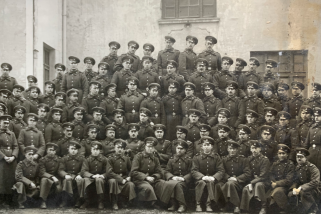Issue 17 – Autumn 2015 (Women in arms: from the Russian Empire to Post-Soviet States)
If you wish to submit an article, please first contact the Chief Editor (contact@pipss.org) and send a 100-word abstract in English. For details about the guidelines for article submission please check http://pipss.revues.org/169. The deadline for article submission is March 2015 with publication in Autumn 2015.
The military has never been an exclusively male world (soldiers’ wives, canteen women, nurses, etc.), but the fact that women could bear arms and fight, in the army or other power structures, still remains controversial, calling into question gender roles and social evolution as a whole. In 2006, the Journal of Power Institutions in Post-Soviet Societies (PIPSS.ORG) dedicated one of its issue to the question of Women and/in the Military in Tsarist, Soviet and Post-Soviet Russia (http://pipss.revues.org/448). In this new PIPSS issue, we want to change the focus and tackle the question of women fighters, whether inside the army or in more or less formalized armed group.
While the specificity of the women experience as victims of war and especially sexual violence is increasingly recognized, a parallel tendency has developed among scholars to recognize that women can also be agents of violence. This body of research often draws on a gender approach to war and the military, including reflection on the notion of masculinity, with war being at the same time its ultimate manifestation and a formidable threat to it.
A basic historical overview points to several moments and contexts when women are compelled to, and socially and/or legally authorized to take arms: in radical left and revolutionary or decolonization movements, where the gender role division is put into question; during revolutionary moments, when these social and gender roles are shattered; in wars of resistance to an invader, total wars and wars of annihilation where armed resistance appears as the only option.
Recent publications cover several historical moments and geographical areas in a comparative perspective; the Spanish Civil War, the First and Second World wars, Asian and Latin American guerrillas, (Alison, Bucaille, Capdevila et alii, Cardi and Pruvost, Milquet and Frederic). But these scholarly works rarely include Russia or the post-Soviet States – a context where cases and experiences of women fighters can be traced through history: Nadezhda Durova who served during the 1812 “Patriotic war” against Napoleon ; the XIXth Century social-revolutionary and terrorist movements, where women terrorists like Sofia Perovskaya climbed onto the scaffold; the First World War, with the well-known figure of Yasha and her women regiment; women Red Guards during the civil war ; women snipers, machine gunners, aviators, tankists or anti-aircraft crew during the “Great Patriotic War” ; women in the local conflicts of the post-Soviet era (Nagorny-Karabakh, Abkhazia, Transdnistria, Chechnya) and women suicide bombers.
Apart from historical overview on women in arms throughout Russian history (Ivanova), or during the First World and subsequent Civil War (Stockdale, Stoff, Salnikova, Shcherbinin, etc) the bulk of publications are dedicated to women during the Second World War (Conze and Fieseler, Engel, Erickson, Harris, Jug, Krylova, Markwick and Cardona, Pennington, Budnitskii, Murmantseva).
Our aim in the 17th PIPSS Issue (2015) is to draw on the renewal of research on women fighters to shed new light on the question of women in arms in Imperial Russia, the Soviet Union, and post-Soviet space. While all contributions dedicated to women fighters and women in arms are welcome, we encourage submissions on the following themes.
– Women and their place in the armed groups: Do women take part in combat? What are the responses of those serving alongside them and among the military hierarchy? How does the military manage the place of women in the armed group (practical questions such as uniform, bath, dormitories, etc.)? What kind of relationships is established between men and women at the front and at the rear? Sexual harassment in the armed forces and the response of military authorities.
– Women’s trajectories: What are the social and personal conditions that allow for women to engage in combat? Contemporary media discourses tends to see women as driven by personal, individual motives (eg. the “black widows” seeking revenge for their loved ones), while during the Second World War the main explanation was “patriotism”. What is the legal and social context as well as the discourses that allow women to take up arms? What are the trajectories of women before the war, during and after the war (including the question of public policies for veterans).
– Representation of women fighters: Soviet literature and cinema have given birth to unforgettable figures, such as Anka the Machine-Gunner in the film Chapaev, Marusia in Forty-first by the writer Boris Lavrenov, or the heroines of “The Dawns here are quiet” by Boris Vassiliev. Papers on representations of women fighters in literature, cinema, theatre, as well as in the press and television, are welcome.
Guidelines for submission
The journal will be published in three languages (French, English and Russian with a 100-word abstract in English), as a result of which most authors will be able to write in their native language. But we would like to draw your attention to the fact that articles in English will reach a much broader audience.
The articles (30 000 to 50 000 characters) submitted to pipss.org for publication should be original contributions and should not be under consideration for any other publication. Each article will be submitted to double-anonymous peer review; final decisions on publication will be made by the Editorial Board.
If you wish to submit an article, please first contact the Chief Editor (contact@pipss.org) and send a 100-word abstract in English. For details about the guidelines for article submission please check http://pipss.revues.org/169.The deadline for article submission is March 2015 with publication in Autumn 2015.
We welcome also shorter research notes (15 000 signs), interviews as well as presentation of unpublished documents. For details contact 17th issue editors contact@pipss.org.
Papers dealing with other issues related to armies and power institutions in the CIS, as well as book review proposals are also welcome.
Book Reviews
Publishers interested in publicizing their editions, please send review copies to: Elisabeth Sieca-Kozlowski , CERSIPS c/° CERCEC, 190-198 av. de France 75244 Paris cedex 13.
Bibliography
Kh. Akhmedova & A. Speckhard, “Black Widows and Beyond, Understanding the motivations and life trajectories of Chechen female terrorists”, in C. N. Ness (ed), Female terrorism and Militancy. Agency, Utility and Organization, London NY, Routledge, 2008, pp. 101-121.
S. Alexiyevich, Wars Unwomanly Face, Moscow, Progress, 1988.
M. Alison, Women and Political Violence. Female combatants in ethno-national conflict, London: Routledge, 2009.
L. Bucaille (dir) « Femmes combattantes », Critique internationale, juillet-septembre 2013/4, # 60.
O. Budnitskii, « Muzhshchiny i zhenshchiny v Krasnoi Armii (1941-1945) », Cahiers du monde russe 2/2011 (Vol 52), pp. 405-422, URL : www.cairn.info/revue-cahiers-du-monde-russe-2011-2-page-405.htm.
A. Caiazza, Mothers and Soldiers: Gender, Citizenship, and Civil Society in Contemporary Russia, Routledge, New York, 2002, 192 pages.
L. Capdevila, F. Rouquet, F. Virgili, D. Voldman, Sexe, genre et guerres, France, 1914-1945, Paris, Payot, 2010.
C. Cardi, G. Pruvost (dir.), Penser la violence des femmes, Paris, La Découverte, coll. «Sciences humaines», 2012, 440 pages.
S. Conze, B. Fieseler, “Soviet Women as Comrades in Arms : A Blind Spot in the History of the War” in R.W. Thurston, B. Bonwetsch, (eds), The People’s War. Responses to World War II in the Soviet Union, Urbana and Chicago, University of Illinois Press, 2000.
N. Durova, The Cavalry Maiden: Journals of a Russian Officer in the Napoleonic Wars, Indiana University Press, 1989
C. Eifler, 2004. ‘“Weil man nun mit ihnen rechnen muss. . .”: Frauen in den Streitkräften Russlands’, in R. Seifert and C. Eifler (eds), Gender und Militär: Internationale Erfahrungen mit Männern und Frauen in den Streitkräften, Königstein: Ulrike Helmer, pp. 101–37.
B. Alpern Engel, “’The Womanly Face of War’: Soviet Women Remember World War II” in N. Dombrowski N. (ed.), Women and War in the Twentieth Century: Enlisted with or without Consent, Garland Publishing Inc., New York, 1998.
J. Erickson, ” Soviet women at War”, in J. Garrard and C. Garrard (eds), World War II and the Soviet People, NY: St Martin’s Press, 2002.
i. Eulriet, Women in the Military : Public Rhetorics and Gendered Policies, Palgrave Macmillan, 2010.
H. Goscilo and Y. Hashamova (eds), Embracing Arms. Cultural Representation of Slavic and Balkan Women in War, Central European University Press, 2012.
A. M. Harris, The myth of the woman warrior and world war II in Soviet Culture, MA, University of Kansas, 2001 (Library of Congress).
Iu. I. Ivanova, Khrabreishie iz prekrasnykh. Zhenshchiny Rossii v voinakh, Moscou, Rosspen, 2002.
St. G., Jug, “Red Army Romance: preserving masculine hegemony in mixed gender combat units, 1943-1944”, Journal of War and Culture Studies Masculinity and War, Jan 2013, # 5.3.
N. Kemoklidze, “Victimisation of Female Suicide Bombers: The Case of Chechnya”, Caucasian Review of International Affairs, 3, 2, 2009, pp. 181-188.
A. Krylova, Soviet women in combat. A history of violence on the eastern front, Cambridge, Cambridge University Press, 2010.
R. D. Markwick, C. E. Charon, Soviet Women on the Frontline in the Second World War, Palgrave Mac Millan, 2012, 336 pages.
S. Milquet, M. Frederic (coord.), Femmes en guerres, Editions de l’Université de Bruxelles, coll. « Sextant » (# 28), 2011.
V. S. Murmantseva, Sovetskie zhenshchiny v Velikoi Otechestvennoi Voine, MP, Mysl 1974, available on http://www.a-z.ru/women/texts/murman1r.htm.
R. Pennington, Wings, Women and War. Soviet Airwomen in World War Two Combat, Lawrence, University Press of Kansas, 2001.
A. Sal’nikova, «I oni khoteli voevat’ : russkie devochki i pervaia mirovaia voina 1914-1918», Adam I Eva, Almanakh gendernoi istorii, red L.I Repina, Moscow, 2005, pp 191-213.
P. Shcherbinin, Pavel, « Gendernye problemy voennoi antropologii », in Voenno-istoricheskaia antropologia, Ezhegodnik, 2005/2006, Moscow, 2007.
M.K. Stockdale, ” ‘My Death for the Motherland is Happiness’ : Women, Patriotism and Soldeiring in Russia’s Great War, 1914-1917 “, American Historical Review, 109:1, February 2004.
L.S. Stoff, They fought for the Motherland : Russia’s Women Soldiers in World War I and the Revolution, Lawrence, KS, University Press of Kansas, 2006.
Yashka, journal d’une femme combattante: Russie (1914-1917) (presented by Stéphane Audoin-Rouzeau and Nicolas Werth), Armand Colin, 2012, 306 pages.












